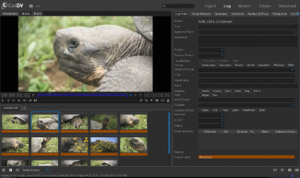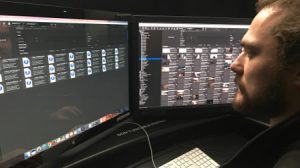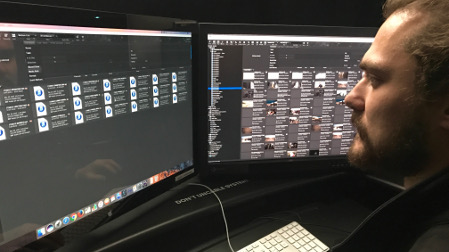OREM, UTAH—Utah Valley University (UVU) is our state’s largest public university. Proudly, UVU also claims the distinction of having introduced the world’s first college degree program in digital media, back in the 1990s when digital technologies were just coming into the mainstream. In the UVU Department of Digital Media, we prepare our students for careers in digital media by teaching foundation theories and procedures for developing sound multi-communication structures. Our emphasis is on integrating graphics, text animation, video and audio digital materials to entertain, educate and communicate ideas through meaningful human interaction.
Asset management has become more complex over the years, compounded by the digital revolution itself. As our students’ video projects have become larger and more sophisticated, we’ve had to keep track of an exploding volume of multi-TB media files. Previously, we used a standardized file-and-folder scheme to store these files on computer hard drives and taught our students how to search and navigate the folder structure. But we had outgrown these traditional methods as the digital files grew in both numbers and size, and it was taking too long to find and access the assets.
TAKING MAM TO THE NEXT LEVEL
 We were looking to adopt a robust media asset management (MAM) system that would address two key goals: education and our own internal MAM requirements as a functioning media operation. Since many of our students come into the program from high school with little or no organizational skills, we wanted to include training on the MAM tool as part of the digital media curriculum. Therefore, it was important to adopt a tool that had widespread use in the industry, to give our students a boost once they entered the workforce. Also, since our upper-level students work on sophisticated video projects, they need the ability to catalog, search for and access very large digital files.
We were looking to adopt a robust media asset management (MAM) system that would address two key goals: education and our own internal MAM requirements as a functioning media operation. Since many of our students come into the program from high school with little or no organizational skills, we wanted to include training on the MAM tool as part of the digital media curriculum. Therefore, it was important to adopt a tool that had widespread use in the industry, to give our students a boost once they entered the workforce. Also, since our upper-level students work on sophisticated video projects, they need the ability to catalog, search for and access very large digital files.
Our choice for these requirements was the CatDV MAM solution from Square Box Systems. As one of the media industry’s most widely deployed MAM solutions, supporting some of the world’s most sophisticated media workflows, we knew it would be robust enough to handle even our largest video projects. At the same time, CatDV is easy to learn and deploy and offers an extremely low cost of ownership, making it an ideal component of our training curriculum.
STRENGHTENING MAM SKILLS
Every semester, Square Box Systems provides us with licenses for CatDV for deploying in our 30 student labs. We’ve placed the software at the core of our “Digital Output for Film” course, a required class for lower-division students that teaches them how to manage assets through a full production workflow from camera files through post and distribution. Upper-division students delve into the software even deeper and work with some of its more advanced features for building search terms and working with metadata.
We’re now in our fifth year of using CatDV in the classroom and we’re considering adding a certification class in the software. Our students are amazed by the power of the system for ingesting assets and assigning metadata according to any attribute such as location, date, featured persons and project category. CatDV teaches them important organizational skills and helps them learn to approach a project in a systematic and disciplined manner.
BRINGING MAM POWER TO STUDENT FILM PROJECTS
One of the things on which our department prides itself is our extremely high level of instruction in digital media. We challenge our students in ways that aren’t seen in other, comparable degree programs; for instance, seniors are expected to finish a film project that’s more on a par with graduate projects in other schools. Here, the CatDV MAM system plays a critical role in helping students manage their video files and finish their projects on time.
 Over the years, UVU student production crews have traveled to many countries to create senior-project documentary films on a wide range of topics. One recent example is the Beit Lehi archaeological site south of Jerusalem in Israel. In partnership with the Beit Lehi Foundation and Jerusalem’s Hebrew University, five separate groups of digital media students have traveled there to film the work of UVU Engineering Graphics and Design Technology students working together with the Beit Lehi archeology team.
Over the years, UVU student production crews have traveled to many countries to create senior-project documentary films on a wide range of topics. One recent example is the Beit Lehi archaeological site south of Jerusalem in Israel. In partnership with the Beit Lehi Foundation and Jerusalem’s Hebrew University, five separate groups of digital media students have traveled there to film the work of UVU Engineering Graphics and Design Technology students working together with the Beit Lehi archeology team.
The resulting documentary projects have generated large quantities of high-volume video files, up to 6TB of data from the most recent Beit Lehi visit. While on location, the students were able to use the CatDV web client to classify and store all of those assets—including video clips and still photographs—in much the same manner as an archeologist would catalog an ancient artifact. Back home in the production facility, the students were able to transcribe the videos and store the transcriptions in CatDV, rather than having to waste valuable time in an edit bay for that purpose. Then, when it came time for editing, they could search for and access the assets they needed quickly and easily.
Speed is of the essence for graduating students who must complete their projects before the term ends, and CatDV gives them the edge they need to work as efficiently as possible. For another documentary project, focusing on the Falco’s Children orphanage in Tanzania, the students were only able to travel to the location during their spring break, which left only another month for them to edit and finish the program. With CatDV, the students were able to come back from the shoot with everything ready to go in CatDV including raw footage, transcripts and B-roll. Through CatDV’s seamless integration with Avid, the students were able to rough out the program on the paper transcript then import it as a .txt file directly into Avid. From there, Avid’s ScripSync “magically” matched each line of text with its corresponding video clip. The resulting rough cut could then be edited quickly and easily into the final result.
A CORE ASSET
Over the past five years, CatDV has become an integral part of the Department of Digital Media. Our success with the tool has spread to other departments as well; for instance, the UVU on-campus production facility is now planning to transfer its entire video catalog over to CatDV from an obsolete Apple MAM system.
Most importantly, CatDV prepares our students for the real world of film and video production by giving them experience on a system that will take them far in their careers.
Dennis Lisonbee is a founding member of the Utah Valley University Department of Digital Media, where he currently serves as associate professor and coordinator of the digital cinema major. Lisonbee began his career in the film and television business before joining UVA almost 30 years ago.

